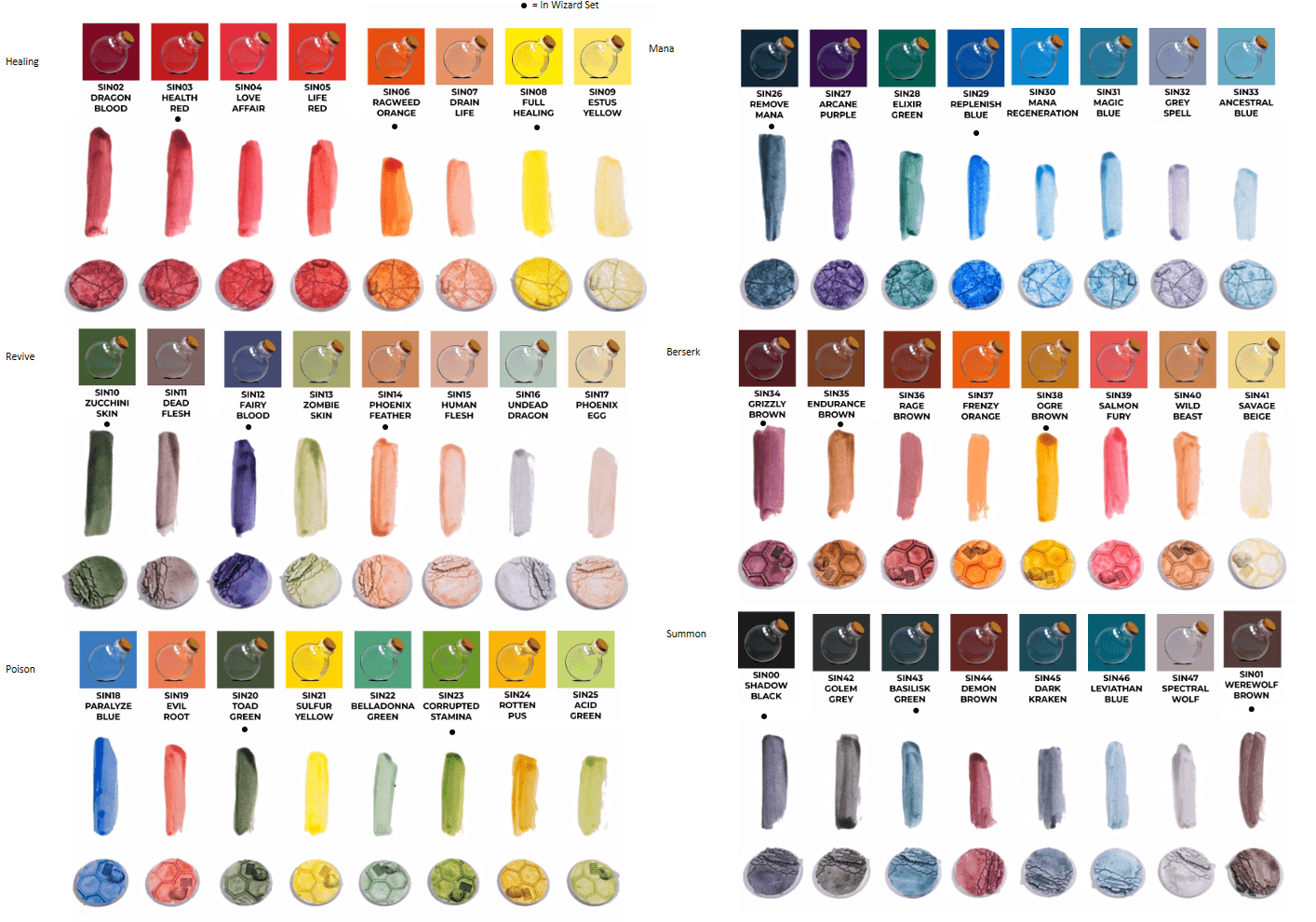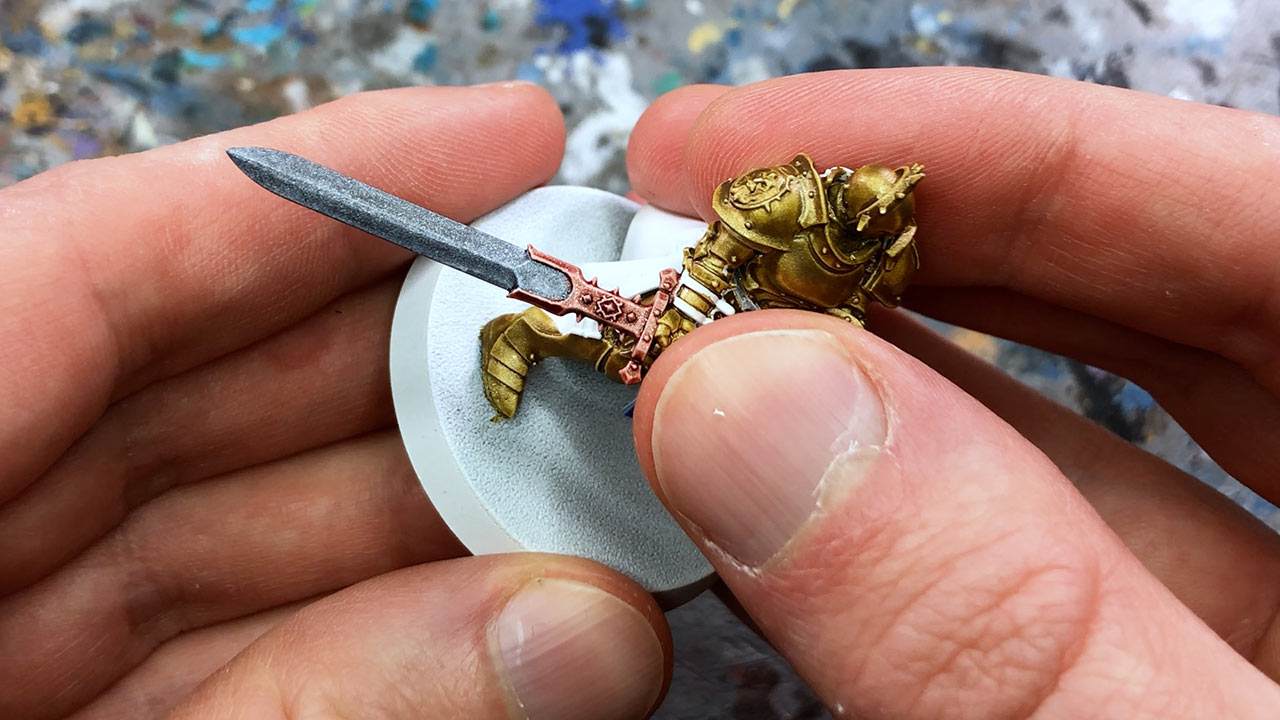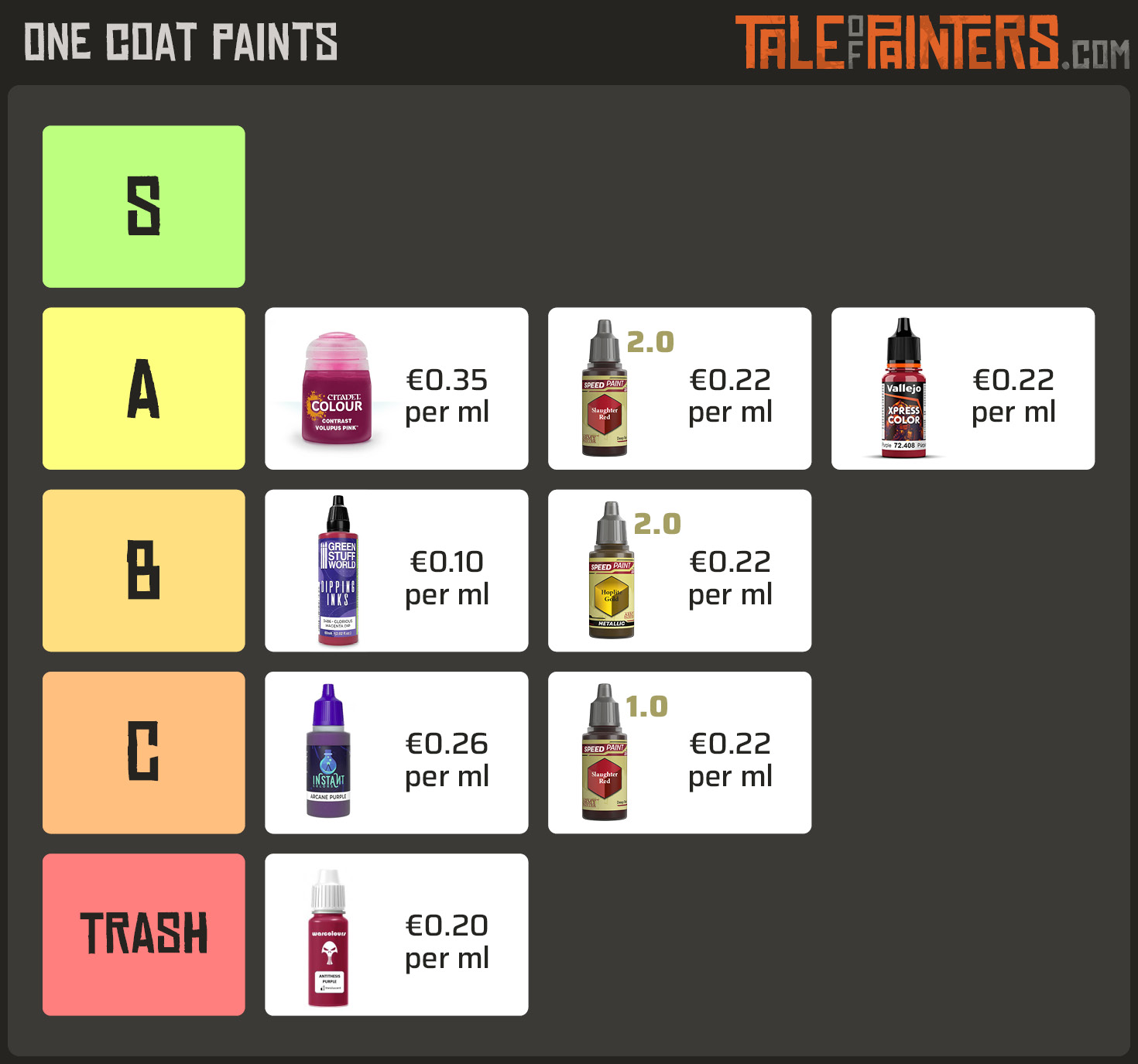For a few years now, one coat paints like Citadel Contrast are all the rage now. In this video I rank and review all one coat paints currently on the market, and help you find an answer to the question of which Contrast-style paint is the best paint for your painting style.
Painting with inks isn’t exactly new. Remember the old Citadel inks? Or artist inks like Liquitex? Traditional inks usually have a quite low viscosity. They shade the recesses and tint smooth surfaces, but often dry rather patchy and glossy. What makes Contrast and other one coat paints special is the medium. And the fact that Games Workshop branded them with a fancy marketing term and turned them into a painting system).
Contrast has a slightly higher viscosity. The special formula of the medium not only shades the recesses and makes the paint dry more evenly on smooth surfaces, it also pulls the paint away from the edges. On a light primer, this helps to create basic highlights and thus adds more contrast to a mini.
In fact, one coat paints have become very popular with quite a few brands competing for your hard earned money. For this ranking I take a look at all the products that are available at the time of the video: Contrast, Speedpaint 2.0, Xpress Colors, Dipping Inks, Instant Colors, and Antithesis paints. Check out the video here:
Stahly’s best one coat paints (tier list)
Citadel Contrast review
We start the tier list with Citadel Contrast from Games Workshop. These are the ones that started the one coat paint trend, the “OG” so to speak. Since they were the first, and since I have the most experience with them, they are my benchmark for all the other paints to come.


And there are a lot of things I like about Contrast. With 61 different colours, there is a lot of choice. The colours are highly saturated and vibrant, and the pigmentation is also high. They don’t reactivate when they’ve dried, and Contrast Medium is my favourite acrylic medium ever. But there are also some disadvantages – varying consistencies across the range, for example. Some colours are rather thin like a wash, others are very pigmented and dark. Some settle more evenly, while others produce a more uneven finish. The second wave also added a few colours that are quite opaque and do provide not much contrast at all. So there is a bit of a learning curve to understand how each colour works. Also, the paints dry very quickly, so you can easily leave visible brush strokes if you’re not careful. They are the only one coat paints available in pots, which I personally don’t like. And of course, they are by far the most expensive per ml.
Overall though, I really like working with Contrast. As I said, they are the benchmark against which all other one coat paints have to measure themselves. I’m putting them in the A tier for now.
You can find my in-depth review of the updated Citadel Contrast range here.
Scale75 Instant Colors review
I’ll stick to the chronological order and rank the Instant Colors from Scale75 next. These were funded as a Kickstarter shortly after the release of Contrast. With 48 colours, the palette is quite large. There are many pastel and muted colours that you won’t find in other one coat paint ranges, which makes this range unique. The paints are available in 17ml dropper bottles and are the second most expensive paints in this comparison. With a price of approx. 4,50 Euro per bottle.


Now what makes Instant Colors so special is the fact that the colours are opaque. Yes, some Contrast colours also contain a certain amount of opaque pigments. You probably noticed the white stuff that settles on the bottom of many of the lighter Contrast paints. Instant Colour’s formula is not based on ink basis but on acrylic pigments. But what makes them special is also their biggest disadvantage. As they are not as transparent as other one coat paints, they are not suitable for painting techniques such as slapchop or zenithal highlights. The opaque pigments will gather in the pre-shaded recesses you want to remain dark. They are also not as rich and vibrant and often require multiple coats to build up a strong colour.
I think Instant Colours are good for more advanced painters who like to use them for glazing, weathering and creating more subtle effects. But using them as a one coat paint as intended, they just lack the dyeing power of other products. If you expect them to work like Contrast you’ll be disappointed. Also, some of the darker colours can reactivate. For now, I put them on the C tier. By no means bad, but they are their own thing and have their own learning curve.
You can find my in-depth review of the Instant Colors range here.
Warcolours Antithesis review
Next, Antithesis paints from Warcolours. They are not very well known, and for good reason. I’m really sorry, Warcolours does some cool products like the Nostalgia range, but Antithesis paints don’t work at all, in my opinion. Imagine regular acrylic paints thinned with a more gel-like medium. They are far too goopey to settle evenly. And they are opaque and not transparent, and thus don’t work for slapchop for the same reasons as Instant Colours.
Honestly, I think you would get better results if you just dilute regular paints with Contrast medium. Trash tier.
You can find my in-depth review of Antithesis paints here.
The Army Painter Speedpaint 1.0 review
Next we have Speedpaints from The Army Painter. These were the first one coat paints that came close to Contrast, and even surpassed them in some regards like flow properties and affordability. However, the original Speedpaint formula had the problem that dried paint reactivated and dissolved when you painted over them with wet paint or a wet brush. Some people didn’t mind this or just used them as intended with no additional layers of paint. Or even took advantage of these properties for interesting blending effects.
But for my painting style and in direct comparison to Contrast, which doesn’t reactivate when dry, I found this too big a disadvantage. That is why I put Speedpaints 1.0 in the C tier.
The Army Painter Speedpaint 2.0 review
The new improved Speedpaint 2.0 formula, however, is a different beast. The reactivation is not gone completely, but colours are now much more stable to the point that it’s hardly an issue anymore. The Army Painter recommends a curing time of about 2 hours. Unless you want to paint over with a very light colour, I found that 30 minutes of drying time should be fine. However, the reactivation-based blending capabilities of the original formula are also mostly gone, more about that in my review here.

With 90 colours, the Speedpaint range is also by far the largest one coat paint range, offering more choice than any other. The consistency and pigmentation is more homogeneous than Contrast, and the colours are vibrant and rich. The flow properties are still very good, Speedpaints settle evenly but still create a good amount of contrast by pulling the paint from the edges nicely. They work very well for Slapchop, or just on their own over a light primer. The 18ml dropper bottles contain as much paint as a pot of Contrast and are more than a third cheaper.
I’m slowly warming up to Speedpaint 2.0, as they have quite a lot of nice colours that I can’t find anywhere else, like some of the browns and darker skintones. I find the reactivation not much of a problem anymore. That’s why I’m putting Speedpaint 2.0 in the A-tier as well.

By the way, the Speedpaint 2.0 range also has ten metallic Speedpaints, which are an industry first and something no other one coat paint range has yet.
The metallic Speedpaints are not bad and will certainly find their fans. By nature, I think they cannot compete with real metallic paints and a wash or drybrush. They are a bit too transparent for my liking, and some have a weird sparkling effect. That’s why the metallic Speedpaints come in the B tier.
You can find my in-depth review of the Speedpaint 2.0 range here.
Green Stuff World Dipping Inks review
Next we have Dipping Inks from Green Stuff World. The range has recently been extended from 24 to 36 colours. What makes these one coat paints so special is the size of the bottles – and the price. A huge 60ml bottle is cheaper than an 18ml pot of Contrast, plus the colours are often on sale on Green Stuff World’s website. The inks apply well, settle well in the recesses, dry smoothly, and overall provide a good contrast effect. But I have to say that for many colours, the pigmentation and intensity is not as rich as with Contrast and Speedpaint. Most feel more like heavy washes. Think of some of the lighter colours from the Contrast range, like Skeleton Bone, Plaguebearer Flesh or Pylar Glacier. That’s not a bad thing per se, just know what to expect.

But there are also a few real disadvantages. The colour palette is somewhat unbalanced – there are a lot of purples and greens, but dark reds, bone colours and greys are missing. Some of the lighter colours are quite opaque, which doesn’t work well for Slapchop as explained earlier. And with some colours, I have noticed that where a lot of paint collects, they can develop small cracks as they dry. However, I only noticed this with the first 24 colours, but not with the 12 new colours. So maybe this is no longer a problem with recent batches.
All in all, Green Stuff World’s Dipping Inks present a mixed picture. There are some really sweet colours that I can’t do without anymore, and the price is awesome. Makes them even feasible for painting terrain. But due to the limited colour palette and the somewhat lower pigmentation, I wouldn’t necessarily recommend them to beginners. At least not to build up a core of one coat paints. I think they’re better for expanding an existing collection with a few distinct colours. Therefore, Dipping Inks just barely miss the A tier and come into the B tier, but l would put them before the metallic Speedpaints.
You can find my in-depth review of Green Stuff World’s Dipping Inks range here.
Vallejo Xpress Colors review
Last but not least, we have Vallejo’s Xpress Colors. The latest and, with 23 colours, the smallest one coat paint range. At just under 4 Euros per 18ml bottle, the colours are on the same level as Speedpaint and thus more than a third cheaper than Contrast.
As Contrast, Speedpaint and Dipping Inks, Xpress Colors are based on inks, and they don’t reactivate. Yet they have a few perks that make them unique: First of all, the darker colours are a bit less pigmented. I found you often have to apply two coats to achieve a similar result to a single layer of Contrast or Speedpaint. They require a good amount of shaking, but then the colours apply very nicely. The consistency is homogeneous across the range. The drying time is a little longer than with Contrast, so there is more working time, making it easier to avoid visible brush strokes. Once dry, they are very matt, which some people prefer, but they also dull metallic paints quite a bit.


Overall, Xpress Colors settle very evenly and add a good amount of shading to the recesses. They also thin nicely into glazes. However, I feel that the medium doesn’t pull the pigments away from the edges quite as much as other one coat paints. So Xpress Colors create a very even finish but slightly less prominent edge highlights. The biggest limitation, however, is the small range, although I have heard that the range will soon be expanded.
Xpress Colors may not have quite the same level of pigmentation of Contrast or Speedpaint, but I still like them quite much. They’re reactivation-free, which is a plus for me. I feel the slightly lower pigmentation and the more uniform finish make them perfect for Slapchop and zenithal basecoats, allowing more of the preshading to show through. The matt finish is pretty nice, and if you want to use them for more advanced painting techniques, then you probably won’t mind applying multiple coats anyways. For this reason they also, surprise surprise, come to the A tier.
You can find my in-depth review of Xpress Color here.
My one coat paint swatches
On my Patreon, you can find a super high-res chart with all colours from the major one coat ranges. Hand-painted on white primer and professionally photographed under neutral 5500K light:


This hand-painted swatch is available in my Patreon shop for a small donation (or by becoming an Autarch tier member). I also have swatches for Citadel Colour, Vallejo Game Color, Warpaints Fanatic, and Two Thin Coats – all cross-compatible with each other so you can compare colours across different brands. Check out my shop for details.
You can also find a collection of all my paint swatches in this post, totally free.
The tier list
Here is my tier list featuring all one coat paints currently on the market. As you can see, we ended up with the A tier being quite crowded, and the S tier empty. Actually, I think I need to think about that again. Each of the three one coat paints in the A tier has its advantages, but also disadvantages. With Contrast it would be the high price and the varying consistencies. With Speedpaint the reactivation, which has been greatly reduced but still not completely fixed, and with Xpress Colors the somewhat lower pigmentation and limited colour range.

On the plus side, I like that Xpress Colors don’t reactivate, as well as the matt finish and that they complement the Slapchop style well. Still, it’s not quite enough for me for the S tier, maybe if they can expand the colour palette. With Speedpaint 2.0 I like the good flow properties, the large selection and the vibrant and rich colours. There is almost no colour that you cannot find. But since the reactivation has not been 100% removed, and you also can’t blend so well with them anymore, I shy away from putting them in the S tier either.
And that leaves us with… Contrast. Sorry, I don’t want to sound like a shill, but I think these would be the ones I would put most likely in the S tier. They were the first, and there’s a good selection of colours. Even if they don’t do everything perfectly, they don’t really do anything bad. And once you get the hang of the different consistencies, they become quite intuitive and versatile. And I have to mention it again, Contrast Medium is the best medium in my opinion.
But in the end, I decided against putting Contrast in the S tier. In my opinion, there is no such thing as the perfect paint range, it’s very much up to personal preference.
Closing thoughts
For example, MY ideal one coat paint would have the vibrancy and colour selection of Contrast and Speedpaint, with some off-beat colours from the Dipping Inks range thrown in. Plus the flow properties of Speedpaint, and the longer working time and matt finish of Xpress Color.
Unfortunately, this doesn’t exist yet, but I hope this video and post will help you find the perfect one coat paint for your painting style. Remember there’s no need to commit to just one paint range alone. Buy a few colours from the ranges you find interesting and see what suits you best. Personally, I also mix and match my favourite colours from each range. Not only with one coat paints, but for miniature paints in general, just be willing to experiment a little.
If you need to expand your paint collection, check out our 🇬🇧/🇪🇺 partner stores Wayland Games, Element Games, and Firestorm Games, at 🇩🇪 Taschengelddieb and PK-Pro, and at 🇺🇸 Noble Knight Games, which all offer an amazing range of paints and hobby products at a discount. Using our links helps to support Tale of Painters at no additional cost to you, so thank you very much for using them!
Let me know in the comments which range is your favourite, leave a reaction if you found this helpful, or head over to our friendly hobby Discord server and share your experiences there. Thanks a lot, and happy hobbying.







